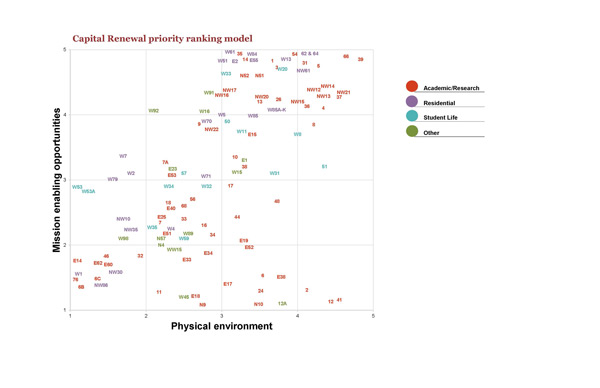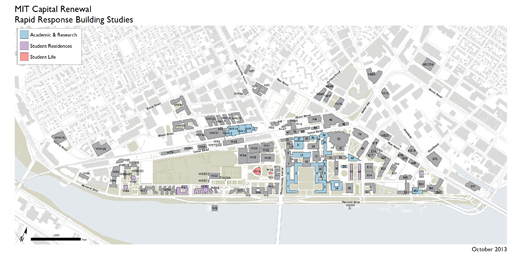Stewardship
Accelerated Capital Renewal initiative (ACR)
During the twelve years between 1999-2010, MIT dedicated a total of $230 million to capital renewal—approximately $20 million/year. Today, we are moving forward with an accelerated plan to commit $250 million in just three years to reduce deferred maintenance and prioritize large renovation projects, strategic building interventions, and critical needs.
A new model for identifying and funding capital renewal needs, the Accelerated Capital Renewal program also establishes a Working Committee and Steering Committee to help guide and prioritize work in collaboration with MIT leadership and existing committees.
Goals of the Accelerated Capital Renewal program
- Maximize the impact of capital renewal investment by funding projects that provide the most benefits in terms of:
- Improving the physical environment (i.e., technical condition, human comfort, user experience and safety)
- Improving the ability of a building or space to advance its occupants goals and, by extension, to advance MIT's mission
- Leveraging an investment by combining system and infrastructure projects with changes that address program needs, and considering opportunities for future research and/or adaptation of space
- Stabilize the physical environment in a selective manner, addressing buildings with the greatest need
- Improve accountability and stewardship of MIT's physical assets
Areas of focus
To maximize the impact of these capital renewal investments, we will engage in projects that have a meaningful impact on the advancement of MIT's mission. Just over half of the $250 million in funds will be dedicated to significant building upgrades involving major systems and substantive programmatic changes. The second largest share of funding will be committed to the replacement of core building systems that are reaching the end of their life cycles. Smaller amounts of funding will go toward repair or replacement of utilities, and to address system failure emergencies.
Identifying priorities
To begin the work of identifying high priority capital renewal projects, the Working Committee gathered information through a widely consultative process. This information included:
- The MIT 2030 campus assessment conducted to determine the conditions of buildings and identify areas of greatest need; and
- Detailed input from MIT's academic, research, and student life leadership regarding their administrative, teaching, research, and resident life priorities and the ways in which space changes might enhance the community's work, enable critical activities, and advance MIT's mission.
The Working Committee analyzed the collected data to identify capital renewal projects that met ACR funding criteria—where significant improvements to a building's physical condition would also significantly improve the academic use of that building, thereby increasing its capacity to advance MIT's mission. The analysis resulted in a list of 49 building candidates that was submitted to the Steering Committee and senior leadership.
This initial group of candidates was narrowed down to a list of 25 buildings that are best suited for ACR capital renewal work based on comprehensive need, opportunities to combine projects and leverage investment, and opportunities to enable the MIT mission.
Guidance and next steps
The ACR initiative governance structure involves representatives from all relevant areas of the Institute. Its Working Committee members assess funding requests and provide day-to-day management of the program, while the Steering Committee sets the direction for the program and oversees its implementation. The Executive Committee of the Corporation, Building Committee, and Committee for the Review of Space Planning (CRSP) provide oversight and program approval.
- Since the launching of the initiative in May 2012, ACR has completed studies of the project candidates, documented each building's physical deficiencies, and developed project options for each building.
- Next, we will set final priorities and select 4-7 significant building upgrade projects to endorse. Preliminary recommendations will be brought back to faculty and senior leadership.
- After the final selections are made and budgets established, the projects will launch.



